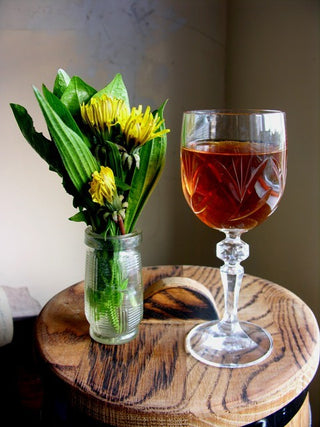Dandelion Wine in a Traditional Wooden Fermenting Barrel - Recipe
Mrs Everybody finds dandelions irresistible – well dandelion wine that is. She has been busy using her wooden fermentation barrels – to make gallons of it! I expect you want to know how to make some of this very special and healthy wine yourself?
Oak barrels add depth of flavour and impart extra health qualities to the finished wine and help to protect the ferment from infection. Even while you are preparing the barrel for use you will get a foretaste of the extra flavour intensity from brewing your wines (or beers) in oak. Tanins, damp forest soil, oak, pine and other essences populate the taste and flavour of oak barrel wine brews.
Mrs Everybody knows when something is wholesome, aromatic and tasty. The finished amber coloured wine has a slightly sherry like aroma and mild medicinal taste with contrasting bitter and honey-treacly overtones. It is really delicious. It is also quite strong!
 I made this dandelion wine 2 years ago but this time I am aiming for even better results by using an oak barrel instead of a plastic fermenting bucket.
I made this dandelion wine 2 years ago but this time I am aiming for even better results by using an oak barrel instead of a plastic fermenting bucket.
Your Equipment
- The 5 liter barrel for 1 demijohn (gallon) or the 10 liter barrel for 2 demijohns. Giving about 6 or 12 bottles respectively.
- 2 demijohns with bungs and air locks. You will need an extra demijohn later on for ‘racking’
- A clean spoon. Wash it with soapnuts (a dried and naturally soapy tree fruit) and sterilize with boiling water.
- Some natural hemp oil soap to give the inside of the barrel a quick clean before soaking it.
- A slotted spoon which can be sterilized with boiling water.
- A sieve which can be sterilized with boiling water.
- A funnel.
- A length of clear hose about 1.5 meters long.
- A wine hydrometer – mine is an easy one which lets you know when you have added enough sugar and when the wine is right for bottling.
- A saucepan in which to dissolve the sugar in boiled water
- A kettle for boiling water or a large stove top pan
- Soapnuts for cleaning everything in the kitchen used for brewing.
- Wine bottle corks, but you will only need these in about 9 months time. Buy good quality corks. You will need a lever action wine corker contraption too.
- A good bottle brush with a long handle.
Ingredients
No chemicals are used by Mrs Everybody in her wine making.
- Freshly picked dandelions – allow 450g of dandelion flowers per gallon and pick them while they are fully open in the sunshine!
- 1.5kg of 3lb of sugar per gallon (use white so that the wine is not discoloured – if you aim to win a wine showing contest, even with your first brew, then the judges will expect the characteristic colour.)
- The juice of one lemon for each demijohn and freshly squeezed orange juice to top up. Some addition of acid is always necessary and it helps to keep the yeast happy and protected at the outset of the fermentation. The oak barrel will also help to protect the wine from spoiling at this stage
- About 1/5 of a sachet wine yeast per demijohn.
- You will also need your soap nuts for cleaning everything and a jar of hemp oil soap for giving the barrel before and after use. That is if you want to keep everything totally natural!
Location
Identify a large patch of dandelions – not right on the edge of a road because dandelions live low down and are subject to splash from road grime. For some reason dandelions grow well on roadsides! Also avoid favourite dog walking locations. Aim to collect dandelions which don’t need washing. Finding a clean dandelion patch where you are allow to gather is the most difficult part and it has been Mrs Everybody’s main mission this April. Commons are possible options, school playing fields, private land or even your lawn. Do gain permission if it is not your land and find out about your rights and responsibilities when it comes to gathering from the wild!Collection dates of Dandelions
The traditional day for gathering dandelions in England is the 24th April, St Georges Day. Although dandelions are so amenable that they will flower in almost any month of the year, the true dandelion season lasts but a few weeks and this is when they all bloom at once. Unfortunately other non-winemakers have a tendency to want to mow them - so act fast before the lawn mower arrives! Always take a carrier bag with you on your travels just in case.Day 1 – The Day Before the Dandelion Harvest
If the barrel is new, then first you will need to wash the inside of the barrel. We use natural hemp oil soap. Then soak the inside of the wooden barrel overnight, or even for a day, so do build this into your schedule. Each barrel comes with instructions on how to do this. Do not skip this step. Always pre-soak the inside of the barrel before use with boiling water, to make the seals tight, according to the instruction sheet.Day 2 – The Day of the Dandelion Harvest
Gather your dandelions from a clean spot on a sunny day once they have been warmed by the sun – they are their most fragrant and wholesome.Day 2 – Primary Fermentation of the Dandelion Flowers in the Oak Barrel
Weigh the right quantity of dandelion flower heads per gallon so 450g for each gallon. I leave the calax on – the green base of the flower but I remove any stalks. Place the flowers in the barrel. I try to gather the dandelions from a very clean source. Washing the flowers even in cold water, removes the pollen which in my opinion provides many of the health benefits of this special wine. However if you feel the need to wash the dandelions, then stand them in cold water, agitate a bit, allow some time for the water to dissolve the dirt, agitate again and lift the dandelions of the water into the barrel. The dirt will hopefully be left in the washing water. With the dandelion in, fill the barrel with water from a boiling kettle until the level is a few inches from the brim. Don’t worry too much about measuring out exact quantities of boiling water. Put the wooden press on the dandelion heads which will want to float. Make sure that they stay immersed under the water. Weigh the press down with washed stones if needed. With the dandelions covered in water, put the lid on the barrel and leave it at normal room temperature for 2 days. Infuse the dandelions for 2 days and no more. Natural enzymatic and low grade fermentation will begin and the ‘goodness’ will begin to extracted from the flowers. Make sure you stir the dandelions once or twice a day and then replace the press and lid. It prevents the parts of the flower on the surface of the liquid from composting!Day 4 – Remove Ingredients, Transfer to Demijohn (s) and Add Ingredients.
Remove the dandelion heads – I use a slotted spoon and a sieve. Then transfer the dandelion infusion into the demijohn (s). I place a sieve over my funnel and pour the infusion into clean demijohn. be careful becuase it is quite an unstable arrangement. The demijohns will not be full up to the beginning of the neck. It is OK as you will need to add sugar –water, and the juice of lemon and orange. Dissolve the sugar in boiled water in a saucepan, stirring with a spoon and add to the demijohn. I aim to dissolve one kilo of sugar in 1 liter of boiled water. Once you are sure that the contents of the demijohn is just less than blood temperature - tepid feeling, add freshly squeezed orange and the lemon juice. When you add the juice, place the sieve over the funnel to keep out excess flesh, any membrane and pips. Add the freshly squeezed lemon and orange juice to top up to the beginning of the neck of the demijohn. Sprinkle the yeast on. Place a solid bung in the demijohn and shake it so everything disperses and plenty of oxygen is brought into the liquid. The oxygen provides a good start for the yeast. Replace with a bung and air lock which has been topped up with boiled water. The barrel is ready for reuse and comes with all the care instructions.Between day 4 and Several Months – Maintenance
Keep the demijohns at a comfortable room temperature and make sure that the air lock doesn’t dry out. I have wiped the inside of the neck of the demijohns a few times because orange flesh seems to accumulate there and again I am making wine not orange compost! Replace the bung and air lock. The cloth I used for this has been washed in soap nut liquid and dried outdoors in the sun. After a few days the fruit pulp will begin to sink and stay beneath the surface. Top up the air locks up with boiled and cooled water as necessary or wash the traps with soapnut liquid and pipe cleaners if needed before refilling them.Month 3 – Rack the Wine
OK quite a lot of time has elapsed. There will be a lot of dead yeast in the bottom of the demijohn. If the wine is left on top of the dead yeast, off-flavours will develop. So clean your spare demijohn again with soapnuts, and use the hose to transfer the rather muggy winey liquid into the new jar, (rack the wine) leaving the yeast sediment behind. Clean the used demijohn out and fit a clean air lock and bung on the fresh jar.Month 3-6 – Second Racking
Keep the air lock topped up. Rack for a second time when dead yeast accumulates on the floor of the demijohn. It is worth doing even if only ½ cm of yeast has fallen. This how to achieve very clear wine and to develop the best flavours.Month 7-9 – Bottle your Dandelion Wine
Wash used wine bottles out with soapnuts. Do not use screw top bottles but ones which were originally sealed with corks. Dry the bottles upside down on a rack in the sunshine. I siphon the wine into a 5 litre jug, leaving any yeast sediment behind in the demijohn and then pout it with the funnel into each wine bottle. A bottle takes about 750ml. It is easier to pour from a jug than from a demijohn. Steam the corks for 3 minutes and use a lever mechanism bottle corker to force the corks into the bottles. If you need to top up the bottles, use a dash of boiled water cooled to room temperature, or some similar existing finished wine. Wash your demi john and equipment with soapnut liquid and a bottle brush straight away.9 Month – 2 Years, Storage of Home Made Wine
Label the bottles and store on their side so that the wine covers the cork. Leave the bottles somewhere coolish and dark. Drink over the course of the next two years. That is unless you are sufficiently disciplined enough to keep the wine for longer! The bottle of dandelion wine which I had to open and taste to complete the blog was 2 years old and the cork was beginning to fail a bit and I don’t think that there is any merit in keeping the wine for longer. Home made fruit wines are significantly different to their commercial counterparts. Even though alcohol consumption in excess is detrimental to the health and happiness, traditionally made home brews have many health virtues too. Moderation is key. Of course there are many ways of utilizing dandelions – the young leaves and flowers are great in salads, but dandelion wine made from the fresh flowers effectively bottles, or initially barrels, the revitalizing Spring sunshine. So happy St Georges Day 2016 - you might be enjoying a glass of your home made, totally natural dandelion wine!Reusing the Barrel
Mrs Everybody knows that 'wet' barrels are intended for continuous use. The 10 L barrel I used was in fact only occupied for 3 days and it has helped Mrs Everybody make two gallons of ultra special flower wine. It won't be empty for long. This is now her ‘wine making barrel’ and she am already planning my next flower wine.
Every part of the process has been pure pleasure, I hope that you try it too!




